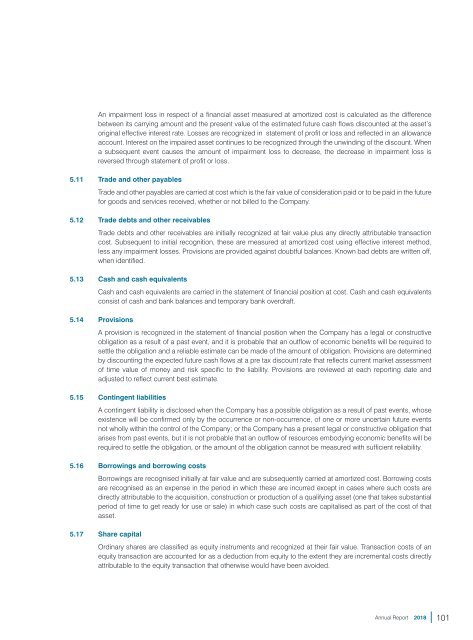MS AR 2018 (1)
You also want an ePaper? Increase the reach of your titles
YUMPU automatically turns print PDFs into web optimized ePapers that Google loves.
An impairment loss in respect of a financial asset measured at amortized cost is calculated as the difference<br />
between its carrying amount and the present value of the estimated future cash flows discounted at the asset’s<br />
original effective interest rate. Losses are recognized in statement of profit or loss and reflected in an allowance<br />
account. Interest on the impaired asset continues to be recognized through the unwinding of the discount. When<br />
a subsequent event causes the amount of impairment loss to decrease, the decrease in impairment loss is<br />
reversed through statement of profit or loss.<br />
5.11 Trade and other payables<br />
Trade and other payables are carried at cost which is the fair value of consideration paid or to be paid in the future<br />
for goods and services received, whether or not billed to the Company.<br />
5.12 Trade debts and other receivables<br />
Trade debts and other receivables are initially recognized at fair value plus any directly attributable transaction<br />
cost. Subsequent to initial recognition, these are measured at amortized cost using effective interest method,<br />
less any impairment losses. Provisions are provided against doubtful balances. Known bad debts are written off,<br />
when identified.<br />
5.13 Cash and cash equivalents<br />
Cash and cash equivalents are carried in the statement of financial position at cost. Cash and cash equivalents<br />
consist of cash and bank balances and temporary bank overdraft.<br />
5.14 Provisions<br />
A provision is recognized in the statement of financial position when the Company has a legal or constructive<br />
obligation as a result of a past event, and it is probable that an outflow of economic benefits will be required to<br />
settle the obligation and a reliable estimate can be made of the amount of obligation. Provisions are determined<br />
by discounting the expected future cash flows at a pre tax discount rate that reflects current market assessment<br />
of time value of money and risk specific to the liability. Provisions are reviewed at each reporting date and<br />
adjusted to reflect current best estimate.<br />
5.15 Contingent liabilities<br />
A contingent liability is disclosed when the Company has a possible obligation as a result of past events, whose<br />
existence will be confirmed only by the occurrence or non-occurrence, of one or more uncertain future events<br />
not wholly within the control of the Company; or the Company has a present legal or constructive obligation that<br />
arises from past events, but it is not probable that an outflow of resources embodying economic benefits will be<br />
required to settle the obligation, or the amount of the obligation cannot be measured with sufficient reliability.<br />
5.16 Borrowings and borrowing costs<br />
Borrowings are recognised initially at fair value and are subsequently carried at amortized cost. Borrowing costs<br />
are recognised as an expense in the period in which these are incurred except in cases where such costs are<br />
directly attributable to the acquisition, construction or production of a qualifying asset (one that takes substantial<br />
period of time to get ready for use or sale) in which case such costs are capitalised as part of the cost of that<br />
asset.<br />
5.17 Share capital<br />
Ordinary shares are classified as equity instruments and recognized at their fair value. Transaction costs of an<br />
equity transaction are accounted for as a deduction from equity to the extent they are incremental costs directly<br />
attributable to the equity transaction that otherwise would have been avoided.<br />
Annual Report <strong>2018</strong><br />
101


